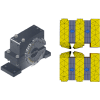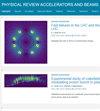低发射率复合弯曲消色差晶格的设计研究
IF 1.8
3区 物理与天体物理
Q3 PHYSICS, NUCLEAR
Physical Review Accelerators and Beams
Pub Date : 2024-06-11
DOI:10.1103/physrevaccelbeams.27.061601
引用次数: 0
摘要
在过去的几十年里,全世界的光源都经历了飞速发展,为了满足用户日益增长的需求,光源都在向更高亮度、更低幅射的方向发展。对更高亮度的追求推动了低幅射环形晶格的发展。目前,所有第四代存储环形光源都采用了多弯消色差(MBA)晶格的变体。在本文中,我们将讨论这种方法的扩展,即与未来 NSLS-II 升级相关的复弯消色差晶格。本文将描述晶格设计的详细方法,并介绍开发的晶格。使用我们的复合弯曲方法的优势显而易见:在 3 GeV 的光束能量下,自然发射率低至 23 pm;为长插入设备提供了 8.4 米的直线截面;获得的自由空间与环周长之比约为 50%。该设计包括使用永久磁铁,在很大程度上减少了对电源的需求。我们的新方法为下一代光源晶格设计提供了 MBA 概念的延伸。本文章由计算机程序翻译,如有差异,请以英文原文为准。

Design study of a low emittance complex bend achromat lattice
Light sources worldwide have experienced rapid growth in the last decades, pushing toward higher brightness with lower emittance to meet growing demands from the user community. The quest for higher brightness motivates the development of low-emittance ring lattices. At this point, all fourth-generation storage ring light sources employ variations of the multibend achromat (MBA) lattice. In this paper, we discuss an extension of this approach, known as complex bend achromat lattice in relation to the future NSLS-II upgrade. A detailed approach for the lattice design will be described and the developed lattice will be presented. The advantages of using our complex bend approach are evident in reaching a natural emittance as low as 23 pm at a beam energy of 3 GeV, providing a straight section of 8.4 m for long insertion devices, and acquiring a ratio of about 50% of free space with respect to the ring circumference. The design includes the use of permanent magnets largely reducing the need for power supplies. Our new approach provides an extension to the MBA concept for the next-generation light source lattice design.
求助全文
通过发布文献求助,成功后即可免费获取论文全文。
去求助
来源期刊

Physical Review Accelerators and Beams
Physics and Astronomy-Surfaces and Interfaces
CiteScore
3.90
自引率
23.50%
发文量
158
审稿时长
23 weeks
期刊介绍:
Physical Review Special Topics - Accelerators and Beams (PRST-AB) is a peer-reviewed, purely electronic journal, distributed without charge to readers and funded by sponsors from national and international laboratories and other partners. The articles are published by the American Physical Society under the terms of the Creative Commons Attribution 3.0 License.
It covers the full range of accelerator science and technology; subsystem and component technologies; beam dynamics; accelerator applications; and design, operation, and improvement of accelerators used in science and industry. This includes accelerators for high-energy and nuclear physics, synchrotron-radiation production, spallation neutron sources, medical therapy, and intense-beam applications.
 求助内容:
求助内容: 应助结果提醒方式:
应助结果提醒方式:


